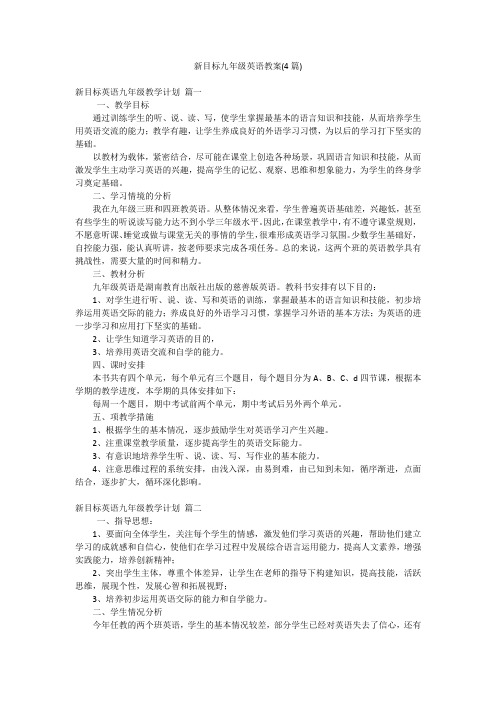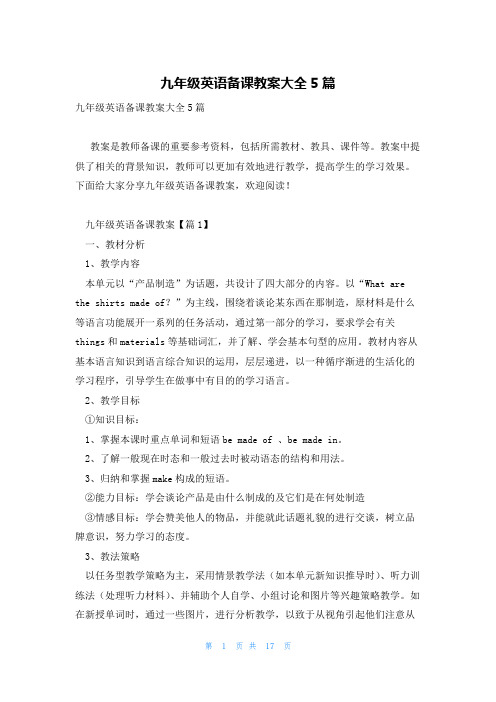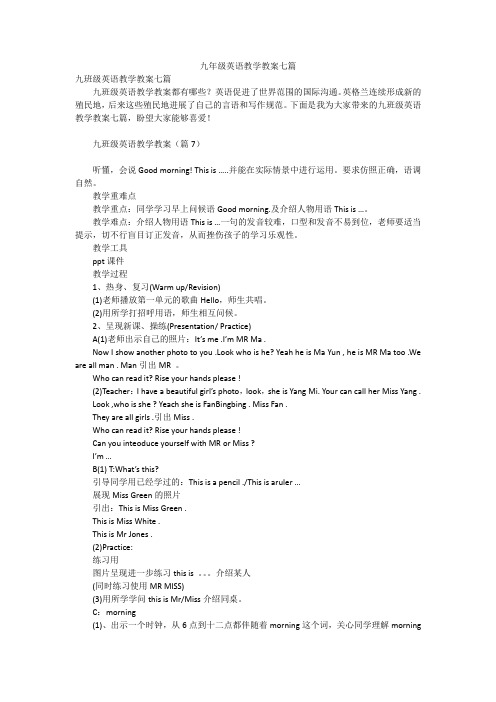初中九年级:英语教案
新目标九年级英语教案(4篇)

新目标九年级英语教案(4篇)新目标英语九年级教学计划篇一一、教学目标通过训练学生的听、说、读、写,使学生掌握最基本的语言知识和技能,从而培养学生用英语交流的能力;教学有趣,让学生养成良好的外语学习习惯,为以后的学习打下坚实的基础。
以教材为载体,紧密结合,尽可能在课堂上创造各种场景,巩固语言知识和技能,从而激发学生主动学习英语的兴趣,提高学生的记忆、观察、思维和想象能力,为学生的终身学习奠定基础。
二、学习情境的分析我在九年级三班和四班教英语。
从整体情况来看,学生普遍英语基础差,兴趣低,甚至有些学生的听说读写能力达不到小学三年级水平。
因此,在课堂教学中,有不遵守课堂规则,不愿意听课、睡觉或做与课堂无关的事情的学生,很难形成英语学习氛围。
少数学生基础好,自控能力强,能认真听讲,按老师要求完成各项任务。
总的来说,这两个班的英语教学具有挑战性,需要大量的时间和精力。
三、教材分析九年级英语是湖南教育出版社出版的慈善版英语。
教科书安排有以下目的:1、对学生进行听、说、读、写和英语的训练,掌握最基本的语言知识和技能,初步培养运用英语交际的能力;养成良好的外语学习习惯,掌握学习外语的基本方法;为英语的进一步学习和应用打下坚实的基础。
2、让学生知道学习英语的目的,3、培养用英语交流和自学的能力。
四、课时安排本书共有四个单元,每个单元有三个题目,每个题目分为A、B、C、d四节课,根据本学期的教学进度,本学期的具体安排如下:每周一个题目,期中考试前两个单元,期中考试后另外两个单元。
五、项教学措施1、根据学生的基本情况,逐步鼓励学生对英语学习产生兴趣。
2、注重课堂教学质量,逐步提高学生的英语交际能力。
3、有意识地培养学生听、说、读、写、写作业的基本能力。
4、注意思维过程的系统安排,由浅入深,由易到难,由已知到未知,循序渐进,点面结合,逐步扩大,循环深化影响。
新目标英语九年级教学计划篇二一、指导思想:1、要面向全体学生,关注每个学生的情感,激发他们学习英语的兴趣,帮助他们建立学习的成就感和自信心,使他们在学习过程中发展综合语言运用能力,提高人文素养,增强实践能力,培养创新精神;2、突出学生主体,尊重个体差异,让学生在老师的指导下构建知识,提高技能,活跃思维,展现个性,发展心智和拓展视野;3、培养初步运用英语交际的能力和自学能力。
九年级英语备课教案大全5篇

九年级英语备课教案大全5篇九年级英语备课教案大全5篇教案是教师备课的重要参考资料,包括所需教材、教具、课件等。
教案中提供了相关的背景知识,教师可以更加有效地进行教学,提高学生的学习效果。
下面给大家分享九年级英语备课教案,欢迎阅读!九年级英语备课教案【篇1】一、教材分析1、教学内容本单元以“产品制造”为话题,共设计了四大部分的内容。
以“What are the shirts made of?”为主线,围绕着谈论某东西在那制造,原材料是什么等语言功能展开一系列的任务活动,通过第一部分的学习,要求学会有关things和materials等基础词汇,并了解、学会基本句型的应用。
教材内容从基本语言知识到语言综合知识的运用,层层递进,以一种循序渐进的生活化的学习程序,引导学生在做事中有目的的学习语言。
2、教学目标①知识目标:1、掌握本课时重点单词和短语be made of 、be made in。
2、了解一般现在时态和一般过去时被动语态的结构和用法。
3、归纳和掌握make构成的短语。
②能力目标:学会谈论产品是由什么制成的及它们是在何处制造③情感目标:学会赞美他人的物品,并能就此话题礼貌的进行交谈,树立品牌意识,努力学习的态度。
3、教法策略以任务型教学策略为主,采用情景教学法(如本单元新知识推导时)、听力训练法(处理听力材料)、并辅助个人自学、小组讨论和图片等兴趣策略教学。
如在新授单词时,通过一些图片,进行分析教学,以致于从视角引起他们注意从而记住单词。
采取任务型教学策略的目的是主要是让学生多练多用,在做中学、学中乐、乐中掌握。
4、学习策略采用合作式学习方式,有目的的让学生预习,在完成任务的活动中主动的学习语言,养成继续学习英语和学好英语的良好习惯。
强调学生不仅要在课上积极发言、多练,并鼓励他们课后积极进行英语学习、积极参加训练。
二、重难点分析重点词汇通过图片和对话解决。
如:chopsticks,coin,blouse,silver,ilk,be made of等。
初三英语教案模板5篇

初三英语教案模板5篇初三英语教案模板5篇作为一位无私奉献的人民教师,就有可能用到教案,教案有利于教学水平的提高,有助于教研活动的开展。
那么你有了解过初三英语教案吗?以下小编在这给大家整理了一些初三英语教案模板,希望对大家有帮助!初三英语教案模板(精选篇1)一、教材分析定语从句是本单元的语法要点,是在1-8单元已经对该语法知识有所渗透的前提下安排的。
本节课话题是让学生体会音乐在生活中无处不在,体会不同类型音乐的特点,学会热爱生活;能用简单的定语从句形式表述自己的观点。
通过本节的学习,增强学生对复合句的理解,提高其对此句式的应用能力。
二、三维目标1、知识目标:掌握本单元基本词汇,学会恰当的使用引导词that ,who2、能力目标1)掌握功能句“What kind of music do you like I like music that I can dance to . I love singers who can write their ownmusic.”2)能够自如地谈论自己所喜欢的音乐和音乐家。
3、情感目标:通过学生谈论对音乐和音乐家的好恶,从而使学生学会欣赏音乐的美。
三、教学重点1)本节课的教学重点是学会并掌握先行词为物或者人时,引导词“that ,who ”的使用方法。
2)“prefer …to…”的用法3)掌握有关音乐的词汇和相关的词组,能够比较流利地描述自己喜欢的音乐,运用功能句“What kind of music do you like I like music that Ican dance to . I love singers who can write their own music.”四、教学难点定语从句运用五、教学策略采用任务型语言教学,实施情境教学法、小组合作探究法、情感激励法。
六、教学准备自制多媒体课件(PowerPoint);录音机(A tape recorder)七、教学环节1、课堂导入⑴ Warming up⑵ Discuss: Do you like music What kind ofmusic do you know⑶ There aremany kinds of music such as pop ,jazz, rock……. Let Sstalk about the kinds of music..(多媒体出示)⑷Let Ss read 1a. Explain the sentences:I prefermusic that has great lyrics=I like music that has great lyrics better.lyrics:the plural form is often used.Ask Ss topractice in pairs then make up a short passage using the four sentences on thescreen.2、课堂讲授Explain attributive clauses.定语从句:在复合句中修饰名词或者代词的从句叫做定语从句。
九年级英语教案(优秀5篇)

九年级英语教案(优秀5篇)篇一:九年级英语的教案篇一Properties:Recorder, Overhead Projector.Teaching Objectives:1、 Revise the grammar: the Adverbial Clause and the Infinitive.2、Revise the use of “who, that, which”。
Language Focus: so thatThe Infinitive: to + Verb(原形)Teaching Procedures:I. Showing the teaching aimsII. RevisionCheck homework, ask some students to retell the story. III. PresentationGive the students some sentences for example to help them understand the structure:so + adj. /adv. + that(结果)1、 I am so angry that I can39;t say a word.2、 The teacher spoke so fast that we couldn39;t catchup with him.3、 The classroom is so dirty that we must clean it. Ask the students to make up some sentences with “so… that”, then give same more sentences.1、 He got up late so that he was late for school.2、 He ran very fast so that he hit the electric pole. Ask the students to do some practice.IV. PracticeLook at Exercise 1, ask the students to answer the questions with so that…。
九年级英语教学教案七篇

九年级英语教学教案七篇九班级英语教学教案七篇九班级英语教学教案都有哪些?英语促进了世界范围的国际沟通。
英格兰连续形成新的殖民地,后来这些殖民地进展了自己的言语和写作规范。
下面是我为大家带来的九班级英语教学教案七篇,盼望大家能够喜爱!九班级英语教学教案(篇7)听懂,会说Good morning! This is …..并能在实际情景中进行运用。
要求仿照正确,语调自然。
教学重难点教学重点:同学学习早上问候语Good morning.及介绍人物用语This is …。
教学难点:介绍人物用语This is …一句的发音较难,口型和发音不易到位,老师要适当提示,切不行盲目订正发音,从而挫伤孩子的学习乐观性。
教学工具ppt课件教学过程1、热身、复习(Warm up/Revision)(1)老师播放第一单元的歌曲Hello,师生共唱。
(2)用所学打招呼用语,师生相互问候。
2、呈现新课、操练(Presentation/ Practice)A(1)老师出示自己的照片:It’s me .I’m MR Ma .Now I show another photo to you .Look who is he? Yeah he is Ma Yun , he is MR Ma too .We are all man . Man引出MR 。
Who can read it? Rise your hands please !(2)Teacher:I have a beautiful girl’s photo,look,she is Yang Mi. Your can call her Miss Yang .Look ,who is she ? Yeach she is FanBingbing . Miss Fan .They are all girls .引出Miss .Who can read it? Rise your hands please !Can you inteoduce yourself with MR or Miss ?I’m …B(1) T:What’s this?引导同学用已经学过的:This is a pencil ./This is aruler …展现Miss Green的照片引出:This is Miss Green .This is Miss White .This is Mr Jones .(2)Practice:练习用图片呈现进一步练习this is 。
九年级英语教案5篇

九年级英语教案5篇九年级英语教案篇1一、教学目标:1. 语言知识目标:1)掌握本单元基础知识,掌握过去完成时的结构和用法。
2)能够根据所学知识进行写作,提高学生的写作能力。
2. 情感态度价值观目标:二、教学重难点过去完成时的用法三、教学过程Ⅰ. Warming up and revision1. Have adictationof the new words and expressions this unit.2. Retellthestories of April Fool’s Day .根据句意,用括号内所给动词的适当形式填空。
1) By the endoflast year, I ___________ (be) to the West Hill Farm three times.2) By the time Igotup, Mom _________ (go) out for some exercise.3)I______________(learn) 1,000 English words by last term.4) By 9 o’clocklastnight, we __________ (get) 200 pictures from the spaceship.5) When I wentintothe classroom, the final bell ___________ (ring).I was happy that Iwasn’tlate.Keys: hadbeenhadgonehad learnedhad gottenhad rung根据句意和汉语提示,填写恰当的短语完成下列句子。
1) He ___________(醒来) very early and went out for a walk inthepark.2) I______________(让她搭便车), so she invitedme to have dinner.3) I hope thatallof you will come to the meeting ____________ (准时).4) Hiscar___________ (出故障), so he had to getit repaired.5) This Mondaymyalarm clock didn’t __________ (发出响声) and I got uplate.Keys: woke up gave her a lifton timebroke downgo offⅡ. Lead-inDo you haveanyexperience on April Fool’s day Now can youremember a lucky or an unlucky dayWhat happened Make some notes about whatyou remember.III. Practice.1. Work on 3a.Makenotes.Can you rememberalucky or an unlucky day What happened Make some notes about whatyouremember.What was thedateWhat happenedfirstWas this luckyorunlucky WhyWhathappenednextHow did thedayendHow did youfeelabout this day2. Share yourideaswith others in class.IV. Writing1. Write astoryabout your lucky or unlucky day and tell your story to a partner or e your notes to write a story about your lucky or unlucky day.写作指导:常见的表达句型:My lucky/unlucky dayI willalwaysremember the date…This wastheluckiest /unluckiest day of my life…When I woke upthatmorning…Later that day…I co uldn’tbelieve…Then/After that…Finally…I think….What alucky/anunlucky day!2. Ask Ss to writeapassage in class.3. Tell yourstoryto your partner or the class.Example:My lucky dayI willalwaysremember the date –April Fool’s D ay last year.This wastheluckiest day of my life.When I woke upthatmorning, I brushed my teeth, washed my face, then I read English for halfanhour. It was time to eat my breakfast. My little brother gave me a pieceofOreo. I was very glad to eat itfirst. Then I felt strange. It tastedspecial.What was it I looked at my little brother. He laughed loudly and saidnothing.Later that day,Iknew he put toothpaste (牙膏) into the Oreo. Icouldn’t believe I wasfooled by him. I brushed my teethagain. After tha t, my brother gave me a box ofOreo, and said “Happy April Fool’s Day.”Finally I washappyto get these delicious biscuits.I think I hadahappy and lucky day.What a lucky day!V. Self-check.Work on SelfCheck1:1. Let some Ssreadthe words in the box. Make sure all the Ss know the meaning of the words.2. Let Ss readthesentences in Self check 1. Then Ss try to fill in the blanks with thecorrectforms of the words in the box.cancelmiss west accidentladyofficermarketunexpectedLast Saturdayaftermy French course, I decided to drive to the________ to buy a meat piefordinner. As I was heading ________, I saw a huge truck in the middle of theroad.There had beena(n)_________ and there were many police _______ around. I turned around anddecidedto go to a nearby mall.However, I________the road that led to the mall. Then I saw a restaurant that soldchickennoodles. I went inside and the _____, who was the owner, served me themostdelicious bowl of chicken noodles ever. I had made a(n) ____________discovery!I’mso glad that I_________ my plan to go to the market.1. Letsome Ss read their answers. Check theanswers with the Ss.Keys: market west accident officersmissedlady unexpected canceled Work on Self check21. Tell Ss thattheyhave to fill in the blanks with Past Perfect Tense. More than one answersmay bepossible.2. Ss think andtryto complete the sentences by themselves.3. Let some Ssreadtheir answers to the class.4. Sharetheiranswers together.e.g.1) A: Why didn’tyouhand in your science homeworkB: Before Icould start working on it, mybaby brother started crying and I had to lookafter him as my mother was sick.2) A: Why didn’tyoutake a shower this morningB: By the time Igotup, my sister had already gone into the bathroom and the bus was honkingfor meto hurry up.3) A: Why didyou have to walk home from schoolB: By the timeIleft my school, the school bus had already left.VI. Exercise1. We ______fourthousand new words by the end of last year.A. learnedB.had learnedC. have learnedD.willlearn2. He told usthathe ______ the letters in the morning.A. willpostB.havepostedC. waspostingD. had posted3. —Did you seeMr Smith when you were in France—No. When I_______ France, he _______ to China.A. had arrivedin;had goneB. arrived in;hasbeenC. got to;hadgoneD. had got to;hadbeenVII. Homework1. 复习本单元内容。
九年级英语仁爱版实用教案5篇
九年级英语仁爱版实用教案5篇九年级英语仁爱版实用教案篇1一、教学目标:1. 语言知识目标:1) 学习掌握下列词汇:France, no matter,local, brand, avoid, product,handbag,mobile, everyday九年级英语仁爱版实用教案篇2学习目标1.重点单词:expression,discover,secret,grammar2重点短语:an English movie called Toy Story,fall in love with,as well,look up3重点句式:The teacher spoke so quicklythat I did not understand her most of the time.I was afraid to ask questionsbecause of my poor pronunciation.I can find the meaningof new words by looking them up in a dictionary.学习重点1.重点短语和句型2.学习英语的方法学习难点学习英语的方法自主学习一、预习课本P3新单词并背诵,完成下面的汉译英。
1.表达_________2.发现________3.秘诀_______4.语法______二、认真预习P3找出下列短语和句型。
1.一部叫做Toy Story的电影2.喜欢上3.也4.老师说得如此的快以至于我大多数时间都不明白。
5.因为我的发音很差,我害怕问问题。
6.我通过在字典里查询找到新单词的意思。
课堂导学Step 1情景导入Teacher:Wei Fen really likes English and sheis a student who is good at English but she didnt use to like English.Do you knowwhat has changed her?Lets read the passageto find the answer.环节说明:由Wei Fen英语成绩的变化为话题,引起学生的好奇,同时又引出要学的内容。
人教版九年级上册英语教案(优秀5篇)
人教版九年级上册英语教案(优秀5篇)(经典版)编制人:__________________审核人:__________________审批人:__________________编制单位:__________________编制时间:____年____月____日序言下载提示:该文档是本店铺精心编制而成的,希望大家下载后,能够帮助大家解决实际问题。
文档下载后可定制修改,请根据实际需要进行调整和使用,谢谢!并且,本店铺为大家提供各种类型的经典范文,如合同协议、条据文书、策划方案、总结报告、党团资料、读书笔记、读后感、作文大全、教案资料、其他范文等等,想了解不同范文格式和写法,敬请关注!Download tips: This document is carefully compiled by this editor. I hope that after you download it, it can help you solve practical problems. The document can be customized and modified after downloading, please adjust and use it according to actual needs, thank you!Moreover, our store provides various types of classic sample essays, such as contract agreements, documentary evidence, planning plans, summary reports, party and youth organization materials, reading notes, post reading reflections, essay encyclopedias, lesson plan materials, other sample essays, etc. If you want to learn about different formats and writing methods of sample essays, please stay tuned!人教版九年级上册英语教案(优秀5篇)九年级是整个初中阶段的重要一年,因此教师需要学习先进的教育理念,认真准备每一次教案。
人教版九年级上册英语教案5篇
人教版九年级上册英语教案5篇人教版九年级上册英语教案(篇1)一、指导思想以我区初中英语教学教研工作为指导,立足学校整体教学工作,以提高教研质量为目标,增强学习意识、服务意识、教研意识、质量意识、合作意识,充分发挥专业职能作用,以新课改为契机,以更新教育教学理念为导向,以课堂教学改革为重点,并注重培养学生的创新精神和实践能力,从而不断深化课堂教学改革,全面提升我校英语教研水平。
二、工作要点:1.加强教学常规的精细化管理,全面提高教学质量。
1).强化教学常规的落实,提高课堂教学效率,组织教师认真学习学校教学常规,指导检查教师的教学工作,进一步加强学科教学五环节的研究与管理,特别抓好“备课”、“上课”、“课后辅导”、“培优辅导”等主要环节,本学期聚焦“上课、作业”环节,注重教学的有效性。
特别在作业上统一标准,统一格式,统一订正,同时根据学生不同情况作业有分层。
2)组织英语课外活动和比赛。
做好期中期末命题的双向分析,跟踪补缺补差学生的成绩,加强月考命题分析的讨论和实施。
及时了解学生学习情况,调整教学和命题。
在教研组内部建立教学评价和质量保证体系,达到自我诊断、自我调节、自主发展的目的。
在英语教学中,我们提倡精选练习,精心编练,因材施教。
进一步做好英语方面的差距和差异的弥补。
加强九年级毕业班工作研究,提高毕业班教学效率。
加强对中考走势的信息收集和测试研究,集中精力,争取在九年级中考中取得一个满意的成绩。
2.?以教科研引领,为教师的专业化成长打造新的平台。
1).大力开展校本教研,拓宽教师课程视野,逐渐成为学习型、反思型教师。
通过同伴互动。
充分发挥学校骨干教师、优秀教师的作用,通过“共享式的集体备课”、“探究式的课堂实践活动”和“专题式的学习讨论活动”等促进教师之间的互动,营造“集体备课、资源共享、个人加减、教后反思”的教研氛围。
结合优质课堂活动,并且推出一节具有代表性的研讨课。
(陈美红老师开课)2).根据各年级特点,进行一次主题教研活动。
九年级英语教案(精选10篇)
九年级英语教案(精选10篇)九年级英语教案篇1一、教学目标:1. 语言知识目标:1) 学习掌握下列单词和短语:block, in linewith, worker, stare, disbelief, above,burn, burning, alive, airport, till ,west2) 能掌握以下句型:Life is full oftheunexpected.I was about to goupwhen I decided to get a coffee first.As I was waitinginline with other office workers, I heard a loud sound.Before I coldjointhe others outside to see what was going on, the first plane had alreadyhit myoffice building.3) 进一步熟练掌握过去完成时的用法。
2. 情感态度价值观目标:1) 通过学习使学生认识到生活中充满着许多出乎预料的事件,培养学生正确看待事物的积极心态。
2)能运用所掌握的语法,句型和词汇进行交流。
3)能比较流利地讲述自己曾经有的特别的一天。
二、教学重难点1. 教学重点:1)掌握本课时中出现的生词block, in linewith,worker, stare, disbelief, above, burn, burning, alive, airport, till ,west2) 学会用过去完成时叙述自己曾经有的特别的一天。
2. 教学难点:用过去完成时叙述自己曾经有的特别的一天。
三、教学过程Ⅰ. Revision1. Could youpleasemake sentences with these words and phrases below?unexpectedadj. 出乎意料的by the time …在……以前backpackn. 背包oversleepv. 睡过头;睡得太久2. Please makeyourown sentences.By the time Igothome, _____________.By the time Icamein, ______________.By the time I gottoschool, __________.By the time thebellrang, ___________.By the time Igotup, _______________.3. Retell thestoryof Mary’sbad day according to the pictures in 1a and 2a.Ⅱ. DiscussionTell Ss Life isfullof the expected. Did you experience the expected things? Share your storywiththe class.Ⅲ. ReadingWork on 3a. Readthepassage and answer the questions:1) Which twoeventsdoes the writer mention?2) How didthewriter end up missing both events?1. Ask Ss to havealook at the questions before they start.2. Let Ss completethework on their own.3. After awhile,ask some students to report their answers to the class.Write the events on the blackboard as theyreport.Keys: 1. Thewritermentions the September 11 attack in New York and theearthquake inNewZealand.2. The writerwent to get a coffee first andwas not in the office when the plane hit theWorld Trade Center. He/she hadoverslept and missed his/her flight, so he/shewas able to avoid theearthquake.4. Aftercheckingthe answers, tell students to read the article again more carefully.Tell them tofindout the words or sentences which they can’tunderstand this time.Do someexplanationand make sure that the students make everything clear about thearticle.5. Ask studentstopick out the sentences with the Past Perfect Tense.Tell them to underline them and come upwith thereason to use the tense.阅读方法指导:快速阅读全文,注意描述事件的关键词或短语,有助于整篇*的理解。
- 1、下载文档前请自行甄别文档内容的完整性,平台不提供额外的编辑、内容补充、找答案等附加服务。
- 2、"仅部分预览"的文档,不可在线预览部分如存在完整性等问题,可反馈申请退款(可完整预览的文档不适用该条件!)。
- 3、如文档侵犯您的权益,请联系客服反馈,我们会尽快为您处理(人工客服工作时间:9:00-18:30)。
新修订初中阶段原创精品配套教材英语教案教材定制 / 提高课堂效率 /内容可修改
English lesson plans
教师:风老师
风顺第二中学
编订:FoonShion教育
英语教案
初三英语:Lesson 23教学设计方案
Period: The third Period
Content: Lesson 23
Properties: Recorder
Teaching Objectives: Students should master the dialogues, useful expressions about the present perfect tense and the object clause.
Language Focus:
1. How long have you lived in…?
I ve live here since…
2. How long have you been doing sth.?
I ve been doing sth. for…
3. What s the longest time you ve been down?
I ve been down as long as…
4. … says (that)…
Teaching Procedures:
Ⅰ. Organizing the class
Greetings and a duty report.
Ⅰ. Revision
To dictate the words last time.
Check homework
Ⅰ. Presentation
Present the sentence:
How long have you learned English?
Ask some students to answer.
Then go on:
Do you like learning English?
Have the students practice this dialogue in Pairs, in groups. At last, act out the dialogue
Ⅰ. Read and say
Play the tape for the students to listen and repeat
Then ask:
How long has Lin Yang lived in Honolulu?
How long has Lin Yang been surfing?
Have the students ask the questions, check with the whole class.
Ⅰ. Practice
Practice the dialogue in Pairs, then in groups.
Then act out the dialogue.
Ⅰ. Ask and answer
Talk about the dialogue of Part 2 in Pairs.
Finish the sentences in Pairs.
Ⅰ. Practice
Talk in groups of three. The first student says something, the second student may ask: What does he / she say? The third student repeats using the Object Clause: He / She says that…
Ⅰ. Homework
Finish off the exercises in the workbook.
Ⅰ. Summary
Exercise in class:
Rewrite the following sentences with the Object clause.
1. Physics isn t easy to learn
He says…
2. Who does live in the room?
Do you know…
3. You have passed the exam.
I m glad…
4. He ll be back in a month.
I hear…
5. Whose dictionary is this?
Tom asked…
Answers:
1. He says (that) physics isn t easy to learn.
2. Do you know who lives in the room?
3. I m glad that you have passed the exam.
4. I hear he ll be back in a month.
5. Tom asked whose dictionary this was.
FoonShion教育研究中心编制
Prepared by foonshion Education Research Center。
